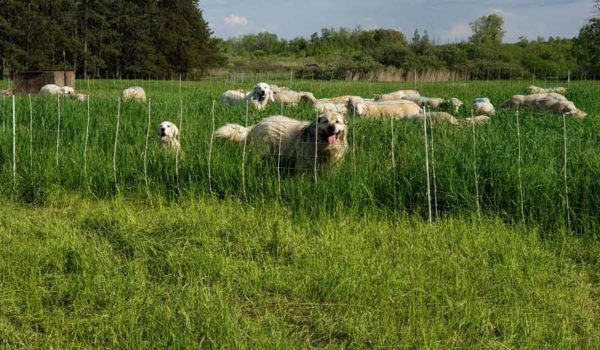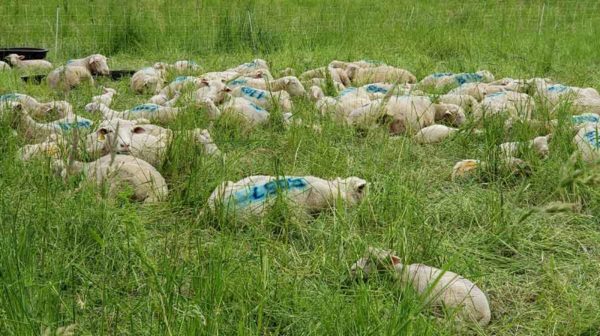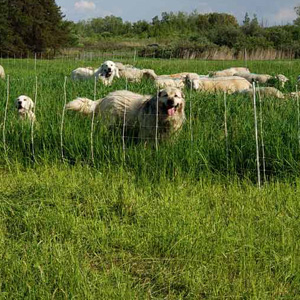By Janet McNally
Hinckley, Minnesota—Years ago I was interested in trying mob-stock grazing that uses higher stocking densities and daily moves.
What held me back was knowing that at some point in early June we would face a tremendous amount of rank growth going to seed and no longer nutritious.
My approach at the time was to have sheep covering every acre in late-May/early-June, biting each plant in an effort to control growth and seedheads.
While this did help keep the plants vegetative and more nutritious, it left my sheep vulnerable to parasites and depredation losses. At the time I did not realize that this short period of continuous grazing was suppressing forage yield as well.
The most urgent issue was that allowing the sheep to spread out widely in the larger paddocks made it too easy for predators to ambush lambs.
A large wolf pack that was causing losses in 1999 forced me to move into a mob-stock grazing method overnight. I needed to consolidate all sheep into a relatively small paddock with all the guard dogs I could muster.
Just like that, I was mob-stock grazing. Now I was forced to tackle the rank growth problem.
Initially I thought I had to make the sheep “eat it down”. I hated to see good, leafy material get trampled into the ground, as I thought it was being wasted.
I also thought the only way to get the plants to produce new vegetative growth was to bite or cut the stem. And I thought that a lot of thatch on the ground would smother the new growth.
Mowing was an obvious answer on smooth and level ground, but that option was not available to me on many rocky pastures that were difficult to even drive an ATV over. I had to solve this with animals.
Mistakes were made
So I tried a variety of management ideas. I found that in attempting to make them eat down the rank forage, animal productivity suffered, both immediately and later on.
My lambing rate went from 190% to 145% in just one year. Lamb body condition suffered as well, and it took longer for them to reach slaughter weight and finish.
The table below explains why attempting to graze the surplus was hurting production.
Digestibility
New leaves: 75%
Old leaves: 65%
Dead leaves: 45%
Green stems: 50%
Dead stems: 35%
Lambs and lactating ewes need a diet that is at least 75% digestible, which is the percentage often being offered by the top three to five leaves of the grass plant. When we force those ewes to eat the lower/older/dying leaves, they are only getting 45-65% digestible dry matter.
Dry ewes are fine with a diet that is only 50% digestible dry matter. So while it would be OK to force dry ewes to clean up some mature forage, we should not ask lactating ewes with lambs to consume anything more than the top three to five leaves (and maybe the very tips of the stems).
This leaves a whole lot of stem and lower leaves unused. What do we do with this material if we cannot mow it?
Getting it right
I found that the answer lies in getting the stocking density right. If you have enough animals per square foot, they will trample the excess growth. If you can get it trampled well, it is possibly even better than mowing, and the new growth will come up through the trampled material.
While I had thought this trampled feed would be wasted, I discovered more grass grew throughout the season and that the pastures were more drought tolerant. I realized that the “waste” was at worst not hurting anything.
I’ve since learned that the trampled vegetation actually helps feed the soil microbiota, insulates the soil, and in general contributes to healthier soils. The more I trampled, the more bioactive my soils became, and the faster the trampled material decomposed and fed the soil.
Figuring the right density
So what is the right stocking density? I don’t know that there is one answer to that question, as there are a lot of “it depends” here. Soil conditions and types of plants, animals and terrain are going to influence what you do.
Perhaps more important is the answer to this question: Are you getting the right result? I will explain what I have done, and hopefully the accompanying photos will show what I see as being good trampling effects.


Last summer I had a flock of 50 adult ewes with lambs. There was some trial and error, such as a paddock being too big and not enough trampling happening, or too small and the sheep eating the less nutritious parts of the plant.
However, soon we settled on paddocks where all sides equaled the length of one-half of a 164-foot roll of sheep netting, with a new paddock provided each day.
Available forage dry matter within these paddocks ranged from 2,600 to 4,500 lbs. per acre. At 4,000 lbs. per acre, this translated to 616 lbs. of available forage in an 82-by-82 foot paddock.
Fifty ewes require 410 lbs. of dry matter/day (8.2 lbs. forage for a 154-pound ewe nursing twins). So the flock was eating approximately 66% of the available forage.
As I noted above, available forage definitely varied from field to field. In less fertile fields I sometimes had to make these paddocks a little bit larger, and sometimes we had to stay a little longer than 24 hours to have them eat enough of what I felt was nutritious feed.
An 82-by-82 foot paddock (half-roll by half-roll) amounts to roughly 134.5 square feet/day per lactating ewe. One needs to resist the temptation to just use that 134.5 square feet per ewe and call it good.
Every pasture is going to be different — even zones within a pasture will be different.
So there is no hard and fast rule. Rather than going by hard numbers, I am more interested in the post-graze residual. Was the trampling effect good? Did they eat the top one-third of the plant?
Obviously, the 66% number mentioned above is more than the top third, and maybe I am still removing too much. But I found that if they were moved too soon, we were not getting enough trampling.
Yet if you need a starting place and live in the more humid regions of the country, what I described would be a place to start. If you can measure your forage and calculate your own paddock size, all the better.
Developing your eye
Now let’s develop your grazing eye, because at the end of the day it is going to be observation that matters most of all.
Keep your eye on two things: Are you getting a good trampling effect, and how do the sheep look?
The photos are the best way to show trampling effect, but basically I want to see most of the plant residue bent over and flat to the ground. I do not want to see a lot of plants just topped off but still standing.
The plants left standing will regrow from the top, which means all that rank material below will remain and become inedible. With good trampling, the new growth will come from the base of the plant and be more vegetative and nutritious when grazed again.
As for the sheep, we want to keep an eye on apparent rumen fill. We want to see nice round bellies. The region between the hip and the ribs is a good place to watch: we do not want this region to be hollow.
If it is hollow, the reason is either lack of rumen fill or a shortage of water. Lack of rumen fill will occur if you are asking the sheep to eat unpalatable plants. This is a good indicator that they have stayed too long in a paddock.
Lack of water may seem obvious, but I mention this because it is an important to know that sometimes the sheep might need water more than a new paddock.
So this is how I learned to get through that rank forage stage: have them eat the tops and trample the rest. Eating the tops is the easy part; getting a good trampling effect took a bit of practice.
The rewards are more and better quality forage later on, plus improved soil health that will allow you to grow even better forage in the future.
Janet McNally grazes sheep near Hinckley, Minnesota

